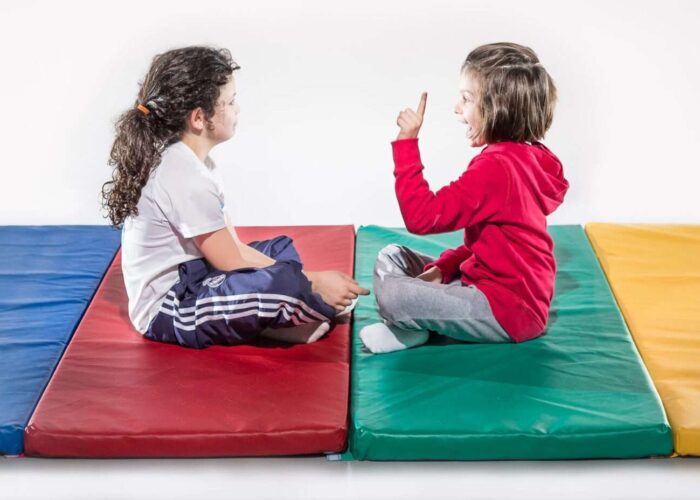What Age Should a Baby Go on a Play Mat?
It’s important to know the right age to put your baby on a play mat. In addition to this, it’s also important to know how to choose a mat. After all, you want to make sure that your child gets all of the benefits of the play mat, but it is also safe.
Can newborns use Playmats?
A baby play mat is a mat that has been designed to help improve the development of babies. They provide a safe, clean, and comfortable surface. They also offer various toys for your baby to enjoy.
Playmats promote gross motor skills, hand-eye coordination, and tactile development. There are different models, sizes, and colors to choose from. Some are made with a variety of colors and textures, while others are a more basic design.
The best time to introduce a play mat to your baby is when they are around three months old. At that point, they will be able to open their hands and reach for toys. But even after this age, babies will still benefit from a play mat.
While playing on a mat, your baby uses their neck and shoulder muscles. This helps develop the muscles that will be needed for crawling.
Baby play mats can be used for tummy time, which is a vital activity for babies. Tummy time is recommended by the American Academy of Pediatrics.
When choosing a play mat, make sure that it’s washable, easy to clean, and interactive. Choose a mat with a variety of textures, colors, and sounds.

What’s the point of a baby playmat?
A baby playmat is a great way to encourage your child’s physical development. It is lightweight, comfortable, and provides a safe and clean area for your child to explore. They are also useful for encouraging eye-hand coordination and motor skills.
Baby playmats are ideal for newborns and new crawlers. Many babies start crawling at around six months of age. When they do, they will want to reach for toys. This is a very important developmental milestone.
Tummy time is also an excellent time to introduce your baby to a layman. Tummy time helps develop your baby’s neck, shoulder, and back muscles.
Your child will learn to use these muscles and develop an understanding of cause and effect by repeating actions and making mistakes. The plasma will help your child explore the world while absorbing the information they learn.
There are many different types of play mats to choose from. Some feature colorful patterns and shapes. Others have bold patterns, including black and white.
Many of the playmates on the market include fun sounds and music. You can also find some that feature lights.
Unlike many other baby products, a play mat is made of special materials that provide your baby with comfort and safety. These materials are also easy to clean.
Can 2 week old use plasma?
A play mat is a padded, interactive mat that promotes developmental activities and learning for infants and toddlers. These play mats encourage hand-eye coordination, gross motor skills, and cognitive development. They are also a comfortable spot for baby tummy time.
Play mats come in a variety of colors, textures, and designs. Many of them incorporate lights, sounds, and toys. The toys help babies develop motor skills, and the bright colors and patterns are attractive to them.
The Fisher-Price Rainforest Music Lights Deluxe Gym is a good choice. It offers a variety of tactile supports to help your baby develop and has four musical toys to provide entertainment.
The Tiny Love Activity Gym for Toddlers features five toys, including a monkey with a teacher. It also includes a tummy-time pillow.
The play mat is made from hypoallergenic materials. It is also water resistant, making it easy to clean. You can fold it up and put it in a bag to take with you on the go.
Babies can use play mats from their first days at home, and some babies enjoy using them after the age of three. Some even continue to use the plasma when they reach preschool.
What are the benefits of a play mat?
A play mat is a great way to stimulate a baby’s development. It offers a cushioned, soft surface that helps develop motor skills, fine motor skills, and cognitive development. Playmats is also a fun and safe way to spend time with your baby.
Babies can use playmats to build hand and eye coordination. They can also be used to encourage muscle development, including shoulder and neck muscles. These muscles are crucial for crawling, sitting up, and rolling over.
Play mats are also great for developing a child’s self-awareness. They help promote trunk stability and encourage a healthy body mass index. You can even take your play mat with you to the park or to a friend’s house.
A well-designed play mat will incorporate a variety of textures, shapes, and colors to stimulate your baby’s brain. Some even come with lights, sounds, and toys to keep your little one busy.
A good play mat will also teach your child to recognize the letters ‘o’ and ‘a’. It will also help them develop visual perceptual skills and spatial awareness.
A play mat will also improve your child’s reasoning skills, hand-eye coordination, and self-awareness. For example, a dangling toy will promote hand-eye coordination, while a hanging rattle will aid in searching for the sound.
Why Baby Play Mats Is Ideal For Creating A Safe
Baby play mats are an essential part of creating a safe environment for your little one. These lightweight mats are ideal for tummy time and overhead play, helping develop your baby’s fine and gross motor skills. They are also a great place for your toddler to practice balance and learn to sit.
A good baby mat should be durable, comfortable, and easy to clean. Make sure you choose a brand that following safety standards and is made from non-toxic materials.
Some baby play mats are made from foam, but it is best to look for mats that use organic materials. Organic materials are non-toxic and made from natural products, which are better for your child’s health.
Another option is to buy a waterproof cover for the mat. This will protect the mat from spills, which occur daily. Also, a waterproof cover can be wiped down with a soft cloth.
You should also consider the thickness of the mat. Your baby will need room to move around, and this can be difficult with a thin mat. Ideally, your mat should be at least an inch thick. If you have hardwood floors, a grippy bottom is a must.
Which is the best baby play mat?
There are many options for baby play mats. You should choose based on your family’s budget and your child’s needs. Some are softer and kinder on the skin, while others are more durable. The materials used in a play mat also have an effect on comfort and ease of cleaning.
For example, a one-piece play mat is easy to clean and is made of durable, non-toxic material. It’s also compact and folds up into a bag.
Another popular choice is the Parklon Bumper Playmat. This product features thick memory foam that is gentle on your child’s delicate skin and effective for learning to walk.
One of the nicer aspects of this product is that it has a lifetime lost part promise. That means you don’t have to buy new gear after your baby grows out of it.
Wee Giggles plays mats don’t contain any toxic chemicals, such as BPA, PVC rubber, or lead. Despite their small size, they come in a variety of shapes and designs. They’re a fun way to get your child interested in toys.
A foam puzzle-style play mat is usually soft and easy to wipe down. However, it’s usually quite expensive.
A reversible playmat from Little Bot is fire-retardant, vacuum-safe, and machine-washable. One side of the mat is a rug, and the other side is a high contrast geometric pattern in neutral tones.
Conclusion
A play mat for babies is an excellent way to promote self-awareness, physical strength, and cognitive development. It can help your baby develop the ability to grasp objects, roll over, and crawl. The soft ground area and sloped edges are also great for reducing the risk of tripping. Some babies enjoy playing with play mats from the moment they are born, while others enjoy them even past the age of crawling. They can also encourage your child’s cardiovascular health and body mass index.
Some play mats are made with high quality manufacturing practices. These products include non-toxic, BPA-free, and phthalate-free materials. They also offer lower odors and include smaller, softer pieces. Some play mats offer more versatile interlocking parts. This helps your baby understand the results and allows for more interaction with the play mat.







